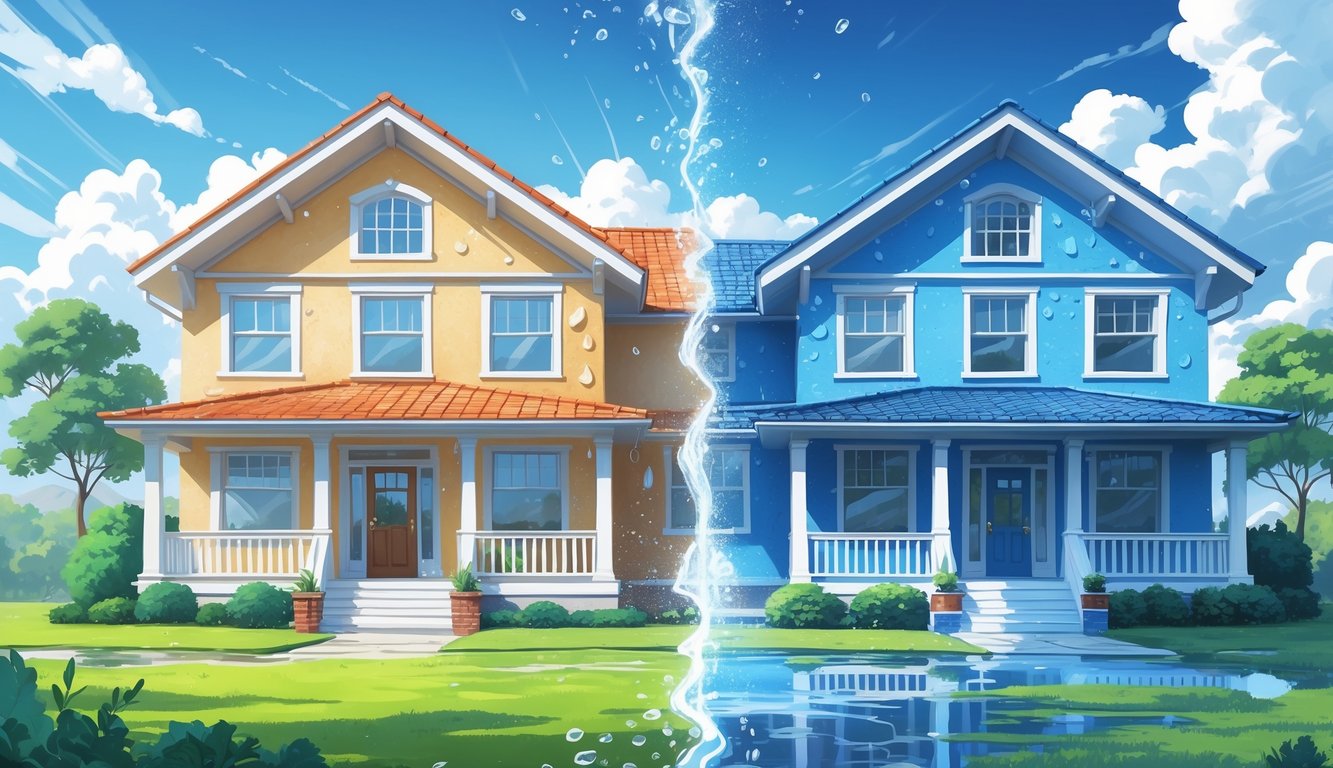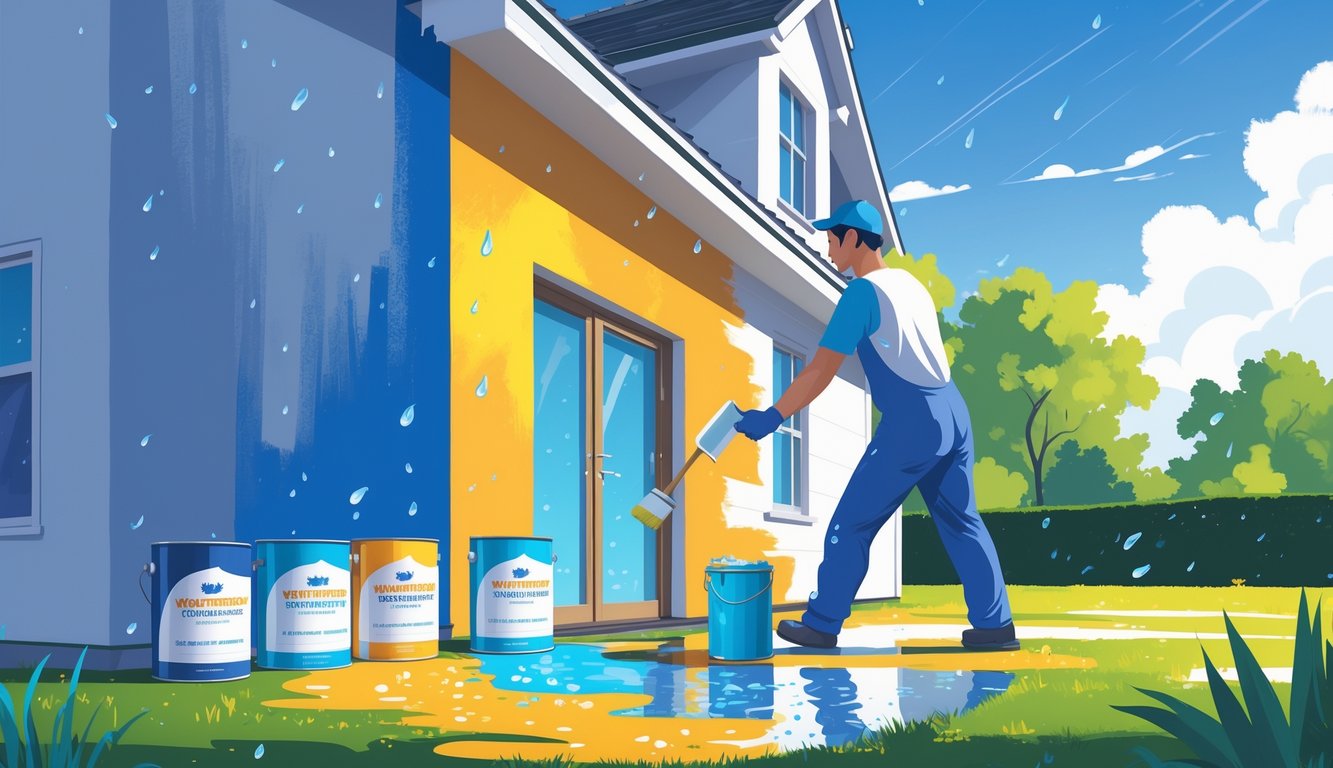
Color Options and Retention
Paint companies have lost their minds with color options—neon blues, fake reds, whatever. But most of them fade or turn chalky if the sun even looks at them. Sales reps love to talk about “multi-year vibrancy,” but Home Depot’s guide says it’s all in the resin, not the color. I once bet pastel yellow would last a year on my west-facing wall. It didn’t. Turns out, you need serious pigment and the right binder or you’re painting again by Christmas.
Weird thing—high-end low-VOC paints sometimes keep color longer. I test by taping off a patch and checking a year later. Good paint matches, cheap stuff fades. Simple.
Boosting Curb Appeal with Weatherproof Paints
Neighbors started asking what I used on my garage doors, which is honestly the only time I’ve felt smug about paint. It’s not just that “fresh paint” look—weatherproof stuff actually stays bright and not chalky, even after a year of rain and sun. The curb appeal isn’t really about wild colors; it’s about the color not looking dead after a season.
Someone once asked if I got new siding. Nope, just two coats of a paint that actually lasts. Good Housekeeping says the best paints can make old siding look less busted, which I guess is true. I’ve argued with people about gloss vs. satin, but honestly, finish barely matters. What matters is if the color survives after a winter.
Application Tips for Outdoor Painting Projects

You’d think weatherproof paint would make things foolproof, but nope—timing and avoiding dumb mistakes matter just as much as the paint. Every year, I see the same disasters: wrong temps, rushing, deck paint peeling off in sheets. Here’s what’s actually useful, not that anyone listens.
Choosing the Best Time and Conditions
Painting a deck in July just because you’re off work? Don’t. I’ve done it—fried myself in the sun, ignored the label (most latex wants 50–85°F), and ended up with sticky streaks. If it rains within 24 hours, just give up.
Humidity’s sneaky. Over 80%? Paint dries slow and sometimes bubbles. Midday sun? The paint cures weird and gets chalky. House Beautiful says to wait for shade or clouds. Also, don’t paint if it’s windy unless you want a paint mist all over your car. My neighbor does it wrong every single year and then acts surprised when his patio looks like burnt toast. Patience saves work, but who has patience?
Easy Application Methods
Brush, roller, sprayer—everyone’s got an opinion. I use a good nylon/poly brush for corners, a ⅜” nap roller for speed, and maybe a sprayer if the wall’s huge (back-rolling is awkward but works). Always use new rollers. Why do people skip drop cloths? I’ll never get it.
Pro tip: feather your edges, keep a wet rag nearby for drips. For decks, thin your latex a bit—it really does help, and weather-resistant coatings guides back me up. My uncle wears gloves so he doesn’t ruin his wedding ring. I forget every time and regret it.
Common Mistakes to Avoid
I get so many “help!” texts from people who skipped prep. Scrape, sand, prime—nobody wants to, but if you don’t, the paint’s gone in a year. Mildew, glossy surfaces, peeling—paint won’t stick. I’ve seen sheds bubble up like science fair volcanoes from trapped moisture. Dumbest mistake? Mixing up interior and exterior products or ignoring dry times. Old world painting pros see it all the time.
Don’t paint in full sun or you’ll get lap lines and have to sand for hours. Power washing right before painting? Go ahead, if you want the paint to peel. My cousin tried shortcuts, now her porch looks like a confetti bomb. Use real exterior tape, not whatever’s in the junk drawer (ask me about my blue-edged “white” door). And don’t leave brushes to crust up—it’s the most common rookie move.
Comparison: Weatherproof Paints vs. Standard Coatings
Here’s what drives me nuts—sun, frost, rain, then suddenly your paint’s crumbling or streaky overnight. One day the place looks decent, next day, random chips and dust everywhere. If you’ve ever obsessed over paint quality just to avoid repainting every year, you’ll get why I’m so picky about what I buy.
Performance in Harsh Conditions
Storms sideways, pollen doing its best to glue itself to siding, then—bam—heat wave. Weatherproof paints, supposedly, are built for this stuff. I mean, Rhino Shield and the like just love to shout “engineered multi-layer protection” like that means anything to my actual house (details). My handyman? He once rolled on some “premium” paint last spring. Looked good for a minute. By July, streak city.
Regular paint? Forget it. Even the “all-purpose” stuff flakes out. Consumer Reports tested a bunch in early 2025—latex, oil, whatever—and half of them faded or chalked up after one rough season (see results).
Weatherproof paints actually do something clever: they toss in additives so the paint flexes with the weather, shrinking and stretching instead of cracking. I groaned at the price, but when you live somewhere that alternates between swamp and tundra, the extra protection is just…obvious. Who’s got time to scrape and repaint trim every time winter chews it up? Not me.
Longevity and Maintenance
Supposedly these things last 15 years. I don’t know, my neighbor’s place got coated in 2012 and it’s still hanging on—looks a little faded, but the paint’s not peeling. Meanwhile, that new house across the street? Already patching up after three years.
It’s not all marketing fluff. Designs4YouSD says you’ll need two coats of regular acrylic, but some weatherproof paints go on thick enough for just one (read more). I noticed I barely have to mess with weatherproof paint—maybe a power wash, no sanding or crack-filling.
Maintenance costs sneak up. You think you’re saving money with cheap paint, but then you’re buying more every couple years. It’s like buying shoes that fall apart after three runs in the rain. Wish more contractors just said, “Yeah, spend a bit more now, touch up less later,” instead of pushing the quick-fix stuff that flakes by spring.